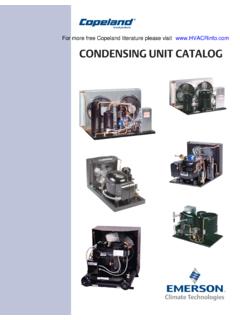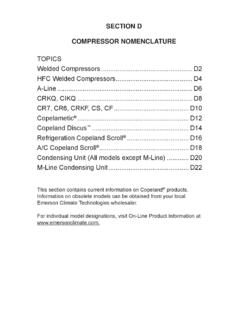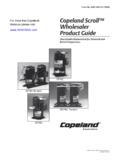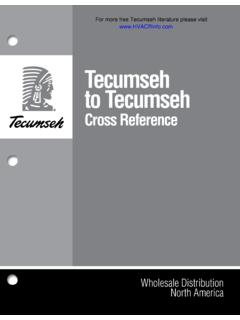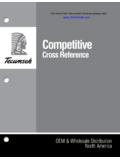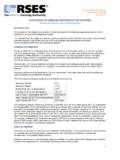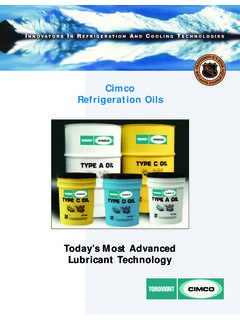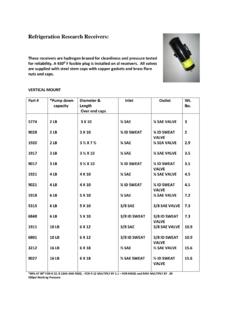Transcription of Electrical Service Parts Guidebook - HVAC
1 Electrical Service Parts GuidebookWholesale Distribution North America1 ELECTRICALSERVICE PARTSGUIDE BOOKT ecumseh Products CompanyAnn Arbor, Michigan 481082 ContentsGeneral Service Safety InformationIntroduction .. 3 Trained Personnel Only .. 3 Terminal Venting and Electrocution .. 4 Refrigerants and Other Chemicals .. 7 Compressor Removal .. 8 System Flushing, Purging, and Pressure Testing for Leaks .. 9 System Charging .. 11 Prevention of Water-Utilizing System Explosions .. 12 Start Capacitor Overheating .. 15 System Evacuation .. 15 Follow the Labels .. 15 Additional Information .. 15 Serial Label Information.
2 16 SAK-Solid State Start Assist Kits .. 19 SSR3-Solid State Relay .. 21 Start Capacitor Ratings .. 23 Run Capacitor Ratings .. 24 Introduction to ESP Master Replacement Guide .. 25 ESP Master Replacement Guide .. 26 Introduction to Electrical Drawings .. 62 Trouble Shooting and Service Chart .. 843 IntroductionTecumseh Products Company has prepared this Guidebook to assist Service personnel in safely working with refrigeration and air conditioning equipment that uses Tecumseh Products Company hermetic compressors. It is not designed to replace the training required for professional Service personnel.
3 It is also not intended to replace other information available from refrigeration and air conditioning equipment Personnel OnlyServicing, repairing, and troubleshooting refrigeration and air conditioning systems should be done only be those with the necessary knowledge, training, and Service , repair, or troubleshoot unless you are qualified to perform these functions. Improper servicing can lead to serious injury or death from fire, Electrical shock, or Venting and ElectrocutionImproperly servicing, repairing, or troubleshooting a compressor can lead to electro-cution or fire due to terminal venting with ignition.
4 Follow the precautions below to avoid serious injury or death from electrocution or terminal venting with Hazard from Terminal Venting with IgnitionOil and refrigerant can spray out of the compressor if one of the terminal pins is ejected from the hermetic terminal. This terminal venting can occur as a result of a ground fault (also known as a short circuit to ground) in the compressor. The oil and refrigerant spray from terminal venting can be ignited by electricity and produce flames that can lead to serious burns or death. See figures 1 through 3 for 1 Compressor with (1) protective terminal cover and (2) bale strap removed to show (3) hermetic Venting and Electrocution PrecautionsTo reduce the risk of electrocution or serious burns or death from terminal venting with ignition:Be alert for sounds or arcing (sizzling, sputtering or popping) inside the compressor, IMMEDIATELY GET AWAY if you hear these ALL Electrical power before removing the protective terminal sure that all power legs are open.
5 (NOTE: the system may have more than one power supply.)Never energize the system unless: 1) the protective terminal cover is securely fastened, and 2) the compressor is properly connected to 4 through 6 illustrate the different means of fastening protective terminal 2 Figure 3 Close-up view of hermetic terminal showing individual terminal pins with power leads view of hermetic terminal after it has 4 Figure 5 Figure 6 Compressor with (1) protective terminal cover held in place by (2) metal bale with (1) protective terminal cover held in place by (2) with (1) snap-in protective terminal reset a breaker or replace a fuse without first checking for a ground fault (a short circuit to ground).
6 An open fuse or tripped circuit breaker is a strong indication of a ground fault (also know as a short circuit to ground). Use only a megohmmeter ( megger ) or a Hi-Potential Ground tester (Hi-Pot) to check for a ground fault. A conventional ohmmeter will not reliably detect a ground fault under certain circumstances. See the Service Handbook for more information on checking for a ground fault. Also, always follow the megger or Hi-Pot manufacturer s procedures and safety a ground fault does exist, keep the power off. WARNING! To avoid electric shock, electrocution, and terminal venting with ignition, do not energize a compressor that has a ground fault.
7 Mark and red tag the compressor to indicate that there is a ground fault. Do not reconnect the power leads. Tape and insulate each power lead power before disconnect power before servicing, unless it is required for a specific troubleshooting technique. In these situations, use extreme caution to avoid Electrical and Other ChemicalsContact with refrigerant, mixtures of refrigerant and oil, or other chemicals can cause a variety of injuries including burns and frostbite. For example, if refrigerant contacts skin or eyes it can cause severe frostbite. Also, in the event of a compressor motor failure, some refrigerant and oil mixtures can be acidic and cause chemical avoid injury, wear appropriate protective eyewear, gloves, and clothing when servicing an air conditioning or refrigeration system.
8 Refer to your refrigerant supplier for more refrigerant or mixtures of refrigerant and oil come in contact with skin or eyes, flush the exposed area with water and get medical attention RemovalFailure to properly remove the compressor can result in serious injury or death from electrocution, fire, or sudden release of refrigerant and these precautions when removing a compressor from a system:Disconnect ALL Electrical all Electrical power supplies to the system, making sure that all power legs are open. (NOTE: The system may have more than one power supply.)Be sure refrigerant is recovered before removing to remove the compressor before removing all refrigerant from the system can cause a sudden release of refrigerant and oil.
9 Among other things, this can: Cause a variety of injuries including burns or frostbite. Cause a fire if a torch is used to disconnect tubing. Expose the Service person to toxic avoid serious injury or death, be sure to remove and recover all refrigerant before removing the a tubing cutter, not a a tubing cutter to remove the compressor. A torch can cause even trace amounts of refrigerant to decompose and release toxic fumes. In addition, using a torch to remove the compressor can cause a fire. If you ignore this recommendation and use a torch, be prepared to extinguish a Flushing, Purging, and Pressure Testing for LeaksFailure to properly flush, purge, or pressure test a system for leaks can result in serious injury or death from explosion, fire, or contact with acid-saturated refrigerant or oil these precautions when flushing/purging a system or pressure testing a system for leaks.
10 Use flushing products according to the manufacturer s purge a system, use only dry pressure testing for leaks, use only regulated dry nitrogen or dry nitrogen plus trace amounts of the serial label purging or pressure testing any refrigeration or air conditioning system for leaks, never use air, oxygen or acetylene. Oxygen can explode on contact with oil. Acetylene can decompose and explode when exposed to pressures greater than approximately 15 psig. Combining an oxidizing gas, such as oxygen air, with an HCFC or HFC refrigerant under pressure can result in a fire or a pressure regulating valve and pressure cylinders of nitrogen contain pressures in excess of 2000 psig at 70 F.


